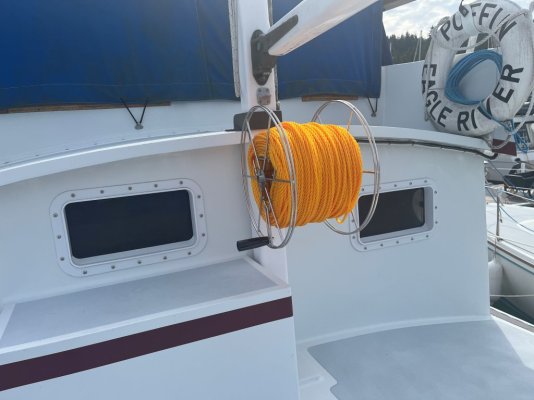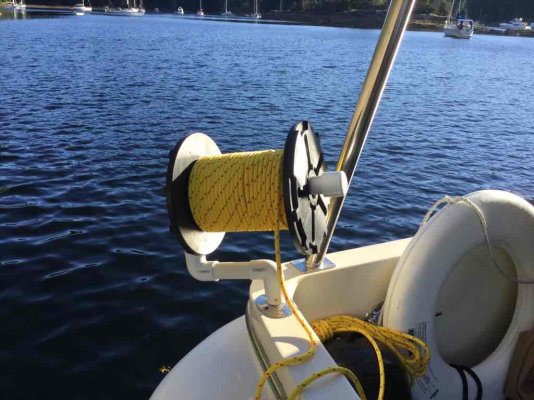I used 600 feet of poly prop stored in a "jump stuff bag"(water resistant) like how technical rescue firefighters store their ropes. Just "stuff" or feed the rope into the bag, it will not tangle. Secure the bag to your boat before going ashore. Unless using a pre-installed stern tie ring (on the rock face), and especially if going around a tree, I used a 6-7 foot bridle, made of 5/8" poly prop with a large ring spliced into one end, and a small ring in the other. On shore, the bridle goes around the tree and the stern tie line is passed through the rings on the bridle going through the small ring first. Using the bridle protects the tree from any "sawing" action as the boat moves in the wind and current. To make getting the stern tie line back to the boat easier, I also used a small messenger line (basically a stout, thick string) on a garden cord reel or similar (so it could self pay out), with a clip secured on the end. When going ashore take the end of both lines and the bridle. On shore, tie after passing the shore tie through the rings, tie a loop in the end and attach the messenger line. Working together, the shore crew (can pull the line from the boat) and the boat crew can "pull" the shore tie back to the boat using the messenger line in a very quick and easy fashion. I have watched many boaters struggle with this part of the operation when not using a messenger line. Cleat the end of the shore tie and pull tight the part of the rope coming out of the stuff bag (take out the slack) before cleating the "other end (part)" leaving any excess rope in the bag and place the bag "out of the way". (When leaving) The stern tie "system" can be retrieved from the boat without going ashore (as the line runs from the boat ashore and back to the boat - 2 legs if you will). First tie a knot in the end of the stern tie line making sure it is large enough to "hang up" on the small ring, but is small enough to pass through the large ring (this gives a good idea of the ring sizes to use). Retrieve the line and the knot will bring back the bridle with it. Be aware that a quick jerking motion can avoid the bridle catching in the rocks on shore once the knot has reached the rings. On rare occasions you may have to go ashore due to "catching", but if done correctly this is very rare.
Hope this helps save some trees, and makes the job of stern tying easier.
FYI. I starting this post last night, and it sounds similar to what sababa talks about.


